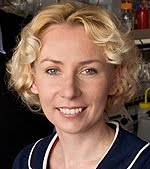 |
| Joanna Wysocka |
Stem cell research generally doesn’t make the news unless it’s a story about diseases and cures. We push toward cures every day here at CIRM, but we also fund a lot of the less flashy science that – though it doesn’t make the daily news – we think will one day underlie many of those future cures.
A recent paper by CIRM grantee Joanna Wysocka at Stanford is one of those that sounds pretty basic but could end up as an important milestone in understanding how human embryonic stem cells form the various types of tissues in the body.
Wysocka, who was last year’s Outstanding Young Investigator at the International Society for Stem Cell Research meeting, found thousands of DNA regions, called enhancers, that control the activity of far distant genes. Of the enhancers they found, more than two thousand carried molecular tags that held the genes in a state much like swimmers at the start of a race – ready to spring to action but also held in check. As the stem cells matured into a given cell type, those tags holding the enhancers in check fell away and the gene was able to spring off the starting block.
In a Stanford press release Wysocka said:
“This is going to be an enormous resource for researchers interested in tracking cells involved in early human development. It will be very interesting to learn how these enhancers affect gene expression in each cell type.”
Having found these enhancers scientists can develop better tools for maturing embryonic stem cells or iPS cells into the desired cell type – heart cells, pancreas, skin, nerves or anything else. Right now, coaxing stem cells to become the desired cell type is a big hurdle and is not terribly efficient for some cell types. Anything that improves that process is a step toward those flashier papers about stem cells and cures.
CIRM Funding: Joanna Wysocka (RN1-00579-1)
Nature, December 15, 2010
A.A.



